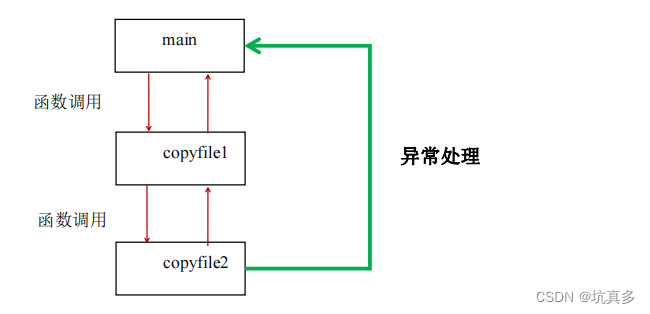第十三站:C++异常处理机制
发布时间:2024年01月23日
概念:
???函数是一种以栈结构展开的上下函数衔接的程序控制系统 ,异常是另一种控制结构, 它可以在出现“意外”时中断当前函数, 并以某种机制(类型匹配)回馈给隔代的调用者相关的信息.
异常处理的基本语法
异常发生第一现场,抛出异常,中断程序void function( ){????????//... ...????????throw 表达式 ;????????//... ...}在需要关注异常的地方,捕捉异常try{????????//程序????????function();????????//程序}catch( 异常类型声明 ){????????//... 异常处理代码 ...}catch( 异常类型 形参 ){????????//... 异常处理代码 ...}catch(...){ // 其它异常类型????????//}① 通过 throw 操作创建一个异常对象并抛掷② 在需要捕捉异常的地方,将 可能抛出异常的程序段嵌在 try 块之中③按正常的程序顺序执行到达 try 语句,然后执行 try 块 {} 内的保护段,如果 有匹配的时候才会执行catch 语句抛出异常,中断程序(以函数体为单位)④如果没有找到匹配,则 缺省功能是调用 abort 终止 程序。
int copyfile2( char *dest, char *src){????????FILE *fp1 = NULL, *fp2 = NULL;????????//rb 只读方式打开一个二进制文件,只允许读取数据????????fopen_s(&fp1, src, "rb" );????????if (fp1 == NULL){????????????????throw new string ( "文件不存在" );//这里抛出一个指针????????}????????????????fopen_s(&fp2, dest, "wb" );????????if (fp2 == NULL){????????????????throw -2;????????}}int main(void){????????int ret = 0;????????try {????????????????ret = copyfile1( "c:/test/dest.txt" , "c:/test/src.txt" );????????} catch ( int error){? //catch(int)只接受到int值????????????????printf( "出现异常啦!%d\n" , error);????????} catch (string *error){ //用指针接收string????????????????printf( "捕捉到字符串异常:%s\n" , error->c_str());????????delete error;????????}}
异常接口声明
?int copyfile2(char *dest, char *src) throw (float, string *, int)
在函数声明中列出可能抛出的所有异常类型,,,没有包含异常接口声明,此函数可以抛出任何类型的异常.如果产生异常声明之外的其它类型的异常就可能导致程序终止.
如果不想抛出任何异常,那么就使用throw();
异常类型和生命周期
?
?异常基础类型:
catch (int error) {
?? ?printf("出现异常啦!%d\n", error);
}
catch (char error) {
?? ?printf("出现异常啦!%c\n", error);
}
异常字符串类型?
if (fp1 == NULL){????????throw new string( "文件不存在" );}????????catch (string *error){????????printf( "捕捉到字符串异常:%s\n" , error->c_str());????????delete error;}
异常类类型
if (fp1 == NULL){????????//ErrorException error1;????????throw ErrorException(); //throw ErrorException();????????//指针 throw new? ErrorException();?}????????catch (ErrorException &error){????????//error.id = 2;????????printf( "出现异常啦!捕捉到 ErrorException &类型 id: %d\n" ,????????error.id);????????} catch (ErrorException *error){????????printf( "出现异常啦!捕捉到 ErrorException *类型 id: %d\n" ,????????error->id);????????delete error;}
异常和继承练习(使用多态)
案例:设计一个数组类容器 Vector ,重载 [] 操作,数组初始化时,对数组的个数进行有效检查1 ) index<0 抛出异常 errNegativeException2 ) index = 0 抛出异常 errZeroException3 ) index>1000 抛出异常 errTooBigException4 ) index<10 抛出异常 errTooSmallException5)?? errSizeException 类是以上类的父类,实现有参数构造、并定义 virtual void printError()
?
#include <iostream>
using namespace std;
/*
1)index<0 抛出异常 errNegativeException
2)index = 0 抛出异常 errZeroException
3)index>1000 抛出异常 errTooBigException
4)index<10 抛出异常 errTooSmallException
5) errSizeException 类是以上类的父类,实现有参数构造、并定义 virtual void printError()
*/
class errSizeException {
public:
errSizeException(int len) {
this->len = len;
};
virtual void printError() {
cout << "errSizeException:size:" << len << endl;
};
protected:
int len;
};
//index<0
class errNegativeException:public errSizeException {
public:
//errNegativeException();
errNegativeException(int len):errSizeException(len){};
virtual void printError() {
cout << "errNegativeException:size:" << len << endl;
};
};
//index = 0
class errZeroException :public errSizeException {
public:
//errZeroException();
errZeroException(int len) :errSizeException(len) {};
virtual void printError() {
cout << "errZeroException:size:" << len << endl;
};
};
//index>1000
class errTooBigException :public errSizeException {
public:
//errTooBigException();
errTooBigException(int len) :errSizeException(len) {};
virtual void printError() {
cout << "errTooBigException:size:" << len << endl;
};
};
//index<10
class errTooSmallException :public errSizeException {
public:
//errTooSmallException();
errTooSmallException(int len) :errSizeException(len) {};
virtual void printError() {
cout << "errTooSmallException:size:" << len << endl;
};
};
class Vector {
public:
//构造函数
Vector(int len) {
if (len<0){
throw errNegativeException(len);
}
else if (len == 0) {
throw errZeroException(len);
}
else if (len > 1000) {
throw errTooBigException(len);
}
else if (len < 10) {
throw errTooSmallException(len);
}
this->len = len;
m_len = new int(len);
}
int getLen() {
return len;
}
//析构函数
~Vector() {
if (!m_len){
delete[] m_len;
m_len = NULL;
len = 0;
}
}
//下标运算符重载
int& operator[](int dex) {
return m_len[dex];
}
private:
int len;
int* m_len;
};
int main(void) {
try{
Vector aa(-10);
for (int i = 0; i < aa.getLen(); i++){
aa[i] = i;
}
}
catch(errSizeException err){
err.printError();
}
/*catch (errNegativeException &err){
cout << "errNegativeException:size" << endl;
}*/
}
C++标准库的各类异常所代表的异常

谨慎尝试以下代码:
#include <iostream>
#include <exception>
#include <stdexcept>
using namespace std;
class Student {
public:
Student(int age) {
if (age > 249) {
throw out_of_range("年龄太大,你是外星人嘛?");
}
m_age = age;
m_space = new int[1024 *1024 * 100];
}
private:
int m_age;
int* m_space;
};
void main() {
try {
for (int i = 1; i < 1024; i++) {
Student* xiao6lang = new Student(18);
}
}
catch (out_of_range& e) {
cout << "捕捉到一只异常:" << e.what() << endl;
}
catch (bad_alloc& e) {
cout << "捕捉到动态内存分配的异常:" << e.what() << endl;
}
system("pause");
}
文章来源:https://blog.csdn.net/qq_48397625/article/details/135733538
本文来自互联网用户投稿,该文观点仅代表作者本人,不代表本站立场。本站仅提供信息存储空间服务,不拥有所有权,不承担相关法律责任。 如若内容造成侵权/违法违规/事实不符,请联系我的编程经验分享网邮箱:chenni525@qq.com进行投诉反馈,一经查实,立即删除!
本文来自互联网用户投稿,该文观点仅代表作者本人,不代表本站立场。本站仅提供信息存储空间服务,不拥有所有权,不承担相关法律责任。 如若内容造成侵权/违法违规/事实不符,请联系我的编程经验分享网邮箱:chenni525@qq.com进行投诉反馈,一经查实,立即删除!